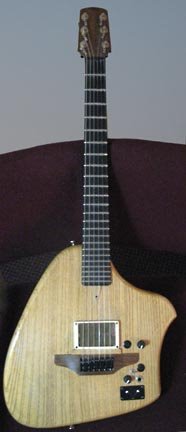Adrian Legg’s Custom Guitar

The guitar virtuoso Adrian Legg plays a great example of a custom guitar made with ergonomics in mind. Built by Bill Puplett, a guitar builder out of England, the guitar bares a striking resemblance to the Klein Electric guitar.
Among the key ergonomic features are the sweeping upper bout which provides plenty of picking hand support and a lower bout shape that helps set the guitar neck at an angle when seated. In addition, the guitar is chambered, which apart from its contribution to the guitar’s tone, reduces its weight as well. Further details about the guitar are available from the Tech Tidbits section of Adrian Legg’s site as well as the Guitar Player article Streaming Vertical Slices – A Lesson with Adrian Legg in Fast, Fluid Fingerpicking.
From a guitar maker’s perspective, this design has a significant advantage over the Klein like guitar I am attempting to build – the use of a conventional neck and bridge. Because headless guitars are far less popular, components such as bridges, necks and head pieces can be difficult to find. When found, they are often significantly more expensive than those available for conventional guitars. Using a conventional neck, bridge and tuners, leads to greater choices and potentially lower costs. For the would be luthier, these are important considerations.
To see the guitar in action, take a look at this video of Adrian Legg. In addition, Adrian Legg plays this guitar on this clip from his Homespun Tapes instructional video.
i like the support for the picking hand offered.
http://guitarguitarguitar.blogspot.com/
earl
I like how the overall look is more compact than the Klein. The Klein, particularly since the plans you based yours on has the 4 sub-bass strings, is kind of large and clunky by comparison.
Aesthetically, I don’t disagree with you regarding the look of Legg’s ergonomic guitar. However, I have noticed in several pictures of Legg that he uses a small pillow or cushion underneath the guitar to raise it a bit which suggests that the guitar doesn’t sit tall enough. The Klein, on the other hand, wouldn’t require this. Finally, the Klein plan I use is a standard Klein body PLUS the 4 harp strings. I merely delete them. BTW, if I’m not mistaken, the harp version was done for guitarist Michael Hedges.
Thanks for the comments!
nice… im also planning to build my own guitar out of a mahogany block. i had made a plan out of a cad software… cheers
Absinth – Thanks for stopping by. Come back soon because my next step will be flush trimming the body. That should be another interesting milestone especially when you consider I’m new to using routers.
Any idea if this guitar is neck heavy?
The Klein design includes a trem unit on the bottom and no weight past the 0 fret so it seems like it would be impossible to get the same balance with the addition of a headstock and no counterweight.
Another nice thing about the Klein body is the notch out of the bottom which allows you to easily play it sitting with the guitar between your legs in a more or less classical guitar posture. The notch fits over your right thigh, and in this position the neck angle is much more perpendicular.
Anonymous – Unfortunately, there isn’t a lot out there on the design but I have been curious about its balance. My assumption is that it would not be neck heavy. The headstock is a short 3×3 design and the body appears to be longer than the Klein which helps counter the weight of the headstock and tuners. While I really like headless guitar designs for a variety of reasons (not all of them related to ergonomics), components can be difficult to obtain which has led me to thinking about a future build based on a conventional bridge and neck. Now that I have my Klein body, I can do a quick experiment by clamping a conventional neck onto it just to get a rough idea.
As far as the Klein “notch”, I agree completely. Its great for classical position. In fact, the Klein is even more balanced in this position than in conventional playing position.